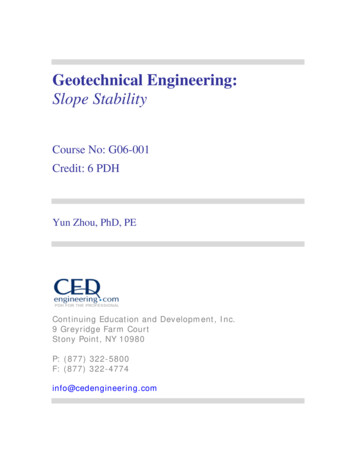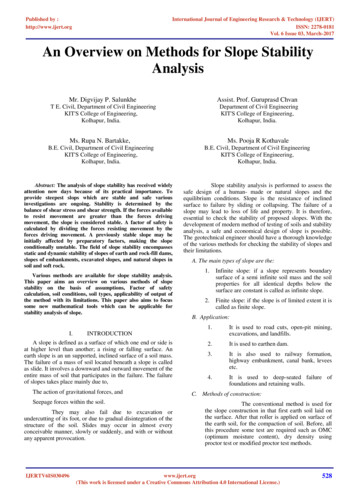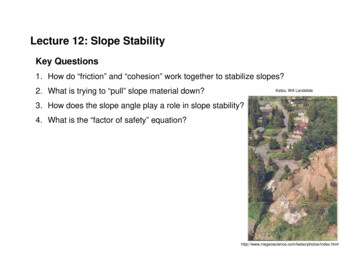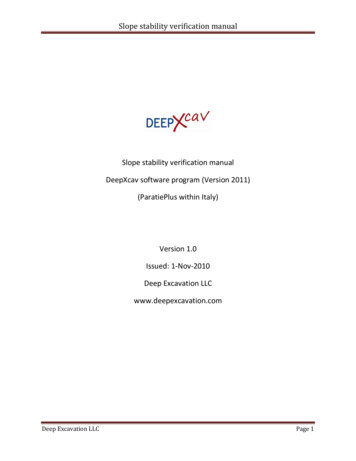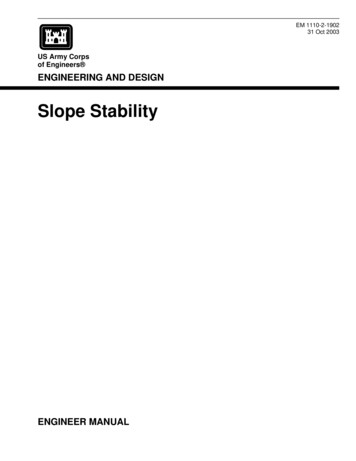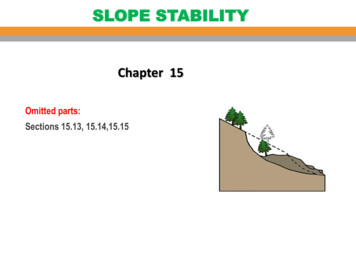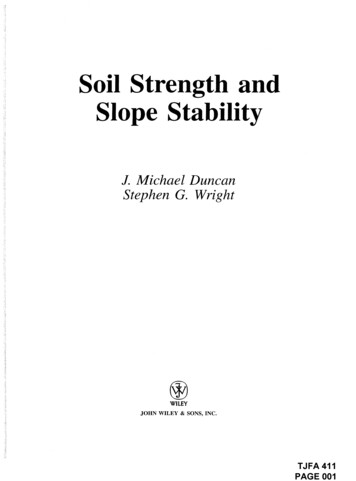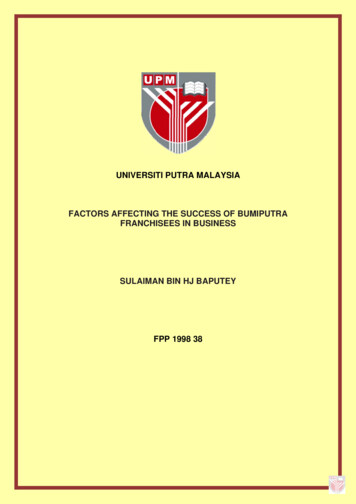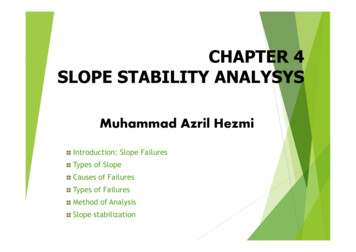
Transcription
CHAPTER 4SLOPE STABILITY ANALYSYSMuhammad Azril HezmiIntroduction: Slope FailuresTypes of SlopeCauses of FailuresTypes of FailuresMethod of AnalysisSlope stabilization
Slope Failureis the movement of mass on slope(falls, slides, flows)Landslide: involves an extensive area, mildslope ( 20o), movement is slow and gradual.Slope Failure: limited area, steep slope,movement is fast (sometimes with no signs)The stability of a slope should be evaluatedwhen slope movement due to additionalload or loss of strength is identified tocause problems.
TYPES OF SLOPENatural Slopes Long term process Short processMan-made SlopesExcavated SlopesSlopes of Embankment and Earth Dam
CAUSES OF SLOPEFAILURESlope inclinationAdditional load or Fill heightExcessive Pore water pressureLoss of shear strength due toWeatheringLiquefactionWater (infiltration and seepage)
TYPES OF FAILURESWedge Failure is the soil mass movement dueto external force. This type of failure usuallyoccur on a weak plane or weak jointCircular Failure or non circular failure,Circular failure are associated with homogeneoussoil conditionsNon-circular slips are associated with nonhomogeneous conditionsTranslational Failures occur where the form offailure is influenced by the presence of weaklayer. The failure surface tends to be plane androughly parallel to the slope surface
TYPES OF FAILURESWedge Failure is the soil mass movement dueto external force. This type of failure usuallyoccur on a weak plane or weak joint
TYPES OF FAILURESCircular Failure or non circular failure,the shape of failure plane maybe circular or non-circular.In general, circular slips are associated withhomogeneous soil conditions while non-circular slips areassociated with non-homogeneous conditions
TYPES OF FAILURESTranslational Failures occur where the form offailure is influenced by the presence of weaklayer. The failure surface tends to be plane androughly parallel to the slope surface
Principle of Slope StabilityAnalysisSliding will occur if the shear stress developedexceeds the corresponding shear resistance of thesoil. In this case, failure is assumes at a certainplaneW sinαPossiblefailuresurfaceRsFS natural slope 1.25 to 1.4FS man-made slope 1.5
METHOD OF ANALYSISLIMIT EQUILIBRIUM METHODSFactor of safety is the shear strength at the time of failureto the stress acting at that plane τm.τf comparedτf 1FS τmIf FS 1, then the slope is in critical condition.At the time of failure, the shear strength of the soil is fully mobilizedalong the failure plane. The shear strength is represented by the MohrCoulomb criteria:τ cu (Total stress analysis)τ c’ σ’ tan φ’ (Effective stress analysis)
METHOD OF ANALYSISLinear Methods: Relatively simple Infinite slope analysis Linear Failure Plane Analysis for the case of φu 0 (undrainedcondition) Wedge failure analysisNon- Linear Methods: Method of SlicesNecessary for irregular slope geometry,non-uniform soil condition, and seepagein soil.
INFINITE SLOPE ANALYSIS1GWTTm z cos2ββWzmzzµFlow netτN or σT orFS γ satγ ' tan φ 'c z cos 2 β sin β γ sat tan β
INFINITE SLOPE ANALYSISThe shear strength along the failure planeτf c' ( σ - μ ) tan φ 'The expression for σ, τ, andµareσ {(1-m)γ m γsat} z cos2 βτm {(1-m)γ m γsat} z sin β cosβµ m z γw cos2β
Substitute the above expressions to getFc' (σ - μ ) tan φ'FS τmcγ' tan φ'FS 2γ sat z cos β sin β γ sat tan βFor special case where c’ 0,FS γ' tan φ'γ sat tan βFor the case where water table is far below the failure plane (m 0)FS tan φ'tanβ
Note that when c’ 0, then factor of safety is independent ofthe height of the slope. The slope will be stable as long asslope angle β is less than the internal friction angle ϕ. Ifboth cohesion and angle of internal friction angle is notzero, then the critical condition (FS 1) will be achievedwhenz z cr c'γ' cos 2β tanφFor a total stress analysis, the shear strengthparameters cu and ϕu are used with a zero value ofm
FINITE SLOPE WITH LINEAR FAILURE PLANEhBN W cosθHRsAβθCWT W sinθLFS Rsc L W cos θ tan φ W sin θW sin θ
From the figure, line AC is the trial failure planeThe weight of soil (ABC) is:1sin (β θ)W γLH2sin βThe force that will cause the failure isT W sinθand the resistance to sliding is given byRs cd L W cosθ tanϕdThe factor of safety will beRsc L W cos θ tan φFS W sin θW sin θ
Critical ConditionsCritical condition prevails when T Rs.By substituting FS 1, thencd sin (β θ )sin (θ φ d ) 1γ H 2sinβcosφd for critical failure plane θ (β φd)/2Substituting θ, we getcd γ H 1 cos (β φ d ) 4 sin β cos φ d And solving for H and replacing cd by c, then4cHcr γ sinβ cosφ 1 cos( β - φ ) Where Hcr is the safe depth of cut and β is the slope angle
Same principal valid for condition where a slopeconsists of two layers where the upper layer is assumedto slide along the interface between the two layershBCN WcosθHWT WsinθDRsAβθL
Circular slope failure
Defining a Failure surface for a toe 353535353740Note: there other charts available as guidelines for findingthe center of failure circle
θRRBdASLOPE WITHCIRCULAR FAILUREPLANE(homogeneouscohesive soils, fu 0)WLaθRyca. No tension crackRBdPwWzcHydrostaticpressure intension crackLab. with tension crack
Slope in HomogeneousCohesive soils, φ 0analysisτf cuτm FS FScuR s τ m La LaFScuW d La RFSFS cu La RWd
In the event of tension crack developing, then La isshortened and hydrostatic force will act normal to the crackif it is filled with watercu La ' RFS W d Pw y c
The use of ChartsTaylor’s stability numberJanbu stability chartsBischop and Morgenstein charts for effectivestress analysisMorgenstein’s graphs for rapid drawdownHere we discuss the Taylor’s stability chart only
The Use of Charts,nd HHβTaylor’s chart
METHOD OF SLICESIn this method, the potential failure surface isassumed to be a circular arc with center O andradius r (see figure).The soil mass (ABCD) above the failure surface(AC) is divided by vertical planes into a series ofslices of width b.The base of each slice is assumed to be astraight line. For any slice, the inclination of thebase to the horizontal line is αi and the height(measured at the centerline) is hi.
METHOD OF SLICESΟxβ9Rα6123748XXii-1Ε ι 1EiWih5ΤιααΝι µbforces acting on a slice
As before,The factor of safety is defined as the ratio of the availableshear strength to the shear stress acting on the planeτfFS τmThe factor of safety is taken to be the same for each slice,implying that there must be support between slices(forces must act between slices)
Forces acting on a slice areThe total weight of the slice, W γbhThe total normal force on the base: the effectivenormal force N’ σ’l and the boundary waterforce U µ l. where u is the p.w.p. at the centerof the base and l is the length of the baseThe shear force on the base, T τm lThe total normal forces on the sides, E1 and E2The shear forces on the sides, X1 and X2Any external forces must be included in theanalysis.
Assumptions must be made regarding theinter-slice forces E and XTaking moment about O, the sum of the moments of the shear forces Ton the failure arc AC must be equal to the moment of the weight ofthe soil mass ABCD. TR W R sin α (τfτl F W sin αfl ) / F W sin αFor analysis in terms of effective stressF(c' σ' tan φ ')l W sin αF orWhere La is the arc length of AC(c' La Σ N ' tan φ ') W sin α
The Fellenius (Swedish) MethodFellenius assumed that the resultant of the inter-slice forces is zero,thenN’ W cos α – ulHence the factor of safety in terms of effective stress is given by:Fm(c' l (W cos β µ l ) tan φ ') W sin αThe components W cosα and W sinα can be determined graphicallywhile angle a can be calculated or measuredFor analysis in terms of total stress parameter or φu 0, thenΣcu LaF ΣW sin α
The Bischop (Routine) MethodBischop assumed that the resultant of the inter-slice forces arehorizontal i.e. X1 –X2 0, then1T (c' l N' tan φ' )FResolving forces in the vertical direction:c' lN'W N' cosα ul cosα sinα tanφ' sinαFFc' l W ulsincosαα F N' tan φ ' sin α cos α F By replacing l b secaAnd after some rearrangementWe obtain:
The Bischop (Routine) Method (cont’d) 1sec α{c' b (W ub) tan φ '}FS ΣW sin a 1 (tan a tan φ ' / F ) By replacing ru u/γh u/(W/b) then: 1sec α{c' b W (1 ru ) tan φ '}FS ()1 tan a tan φ ' / F ΣW sin a
The Bischop (Routine) Method (cont’d)Since F appear in both sides of the equation, then use trialand error.To simplify the calculation, the following chart could be used tan a tanφ ' m cos a 1 aF Then11 {c' b W (1 ru ) tan φ '} FS ΣW sin a ma
To get FS from the equation,can use computer program or1. Assume F right 1,graphfind mα2. Find F left3. Take the average of Fright and F left4. Use this average F,find mα5. Find new F left6. Repeat steps 3 and 4until the differencebetween F right and Fleft is small enough(0.01)reroute to excell programfor Bischop
COMMENT ON SLICESMETHODSDue to repetitive nature of the calculations and the needto select the most critical failure surface, the methodof slices in particularly suitable for solution bycomputer. More complex geometry and soil strata canbe introduced.There are other methods of slices as shown in the followingTable. These methods use different assumption on interslices forces.
Slices methods of analysis frequently used in ape of slip surfaceOrdinary method ofslices (Fellenius, 1927)Does not satisfyhorizontal or verticalforces equilibriumYes.CircularBishops Modified(Bishop, 1955)Satisfy vertical forcebut not horizontalforce equilibriumYes.Circular only. Noncircular may havenumerical problems.Janbu’s simplifiedmethod(Janbu, 1956)YesNoAny shape. Morefrequent numericalproblems than othermethodsMorgenstern and Price(Morgenstern and Price,1965)Yes. Permits sideforces to be variedYes.Any shape.Spencer’s Method(Spencer, 1967)Yes. Side forces areassumed to be parallelYes.Any shape.
ASSIGNMENT 1:SLOPE STABILITY ANALYSIS Pick a problem and the CD manualAnalyze the problem using SLOPE/W student version(in this case you can use Bischop, Janbu or GLEmethods available for Student version).Find the slip surface that gives the lowest factor ofsafety (critical failure surface)Sketch of your slope in graph paper and trace thecritical failure surface you obtained from SLOPE/W onyour graphUse method of slices to calculate the factor of safetyeither using Bischop or Fellenius method (you maymake use of Excell for your calculation).
ASSIGNMENT 1:SLOPE STABILITY ANALYSISDiscuss the results and write a report (Group). The report should includeIntroduction (the problem)Results of SLOPE/Woutput including contour of FS and the critical failuresurface analysis of 1 sliceResults of your manual calculation (with the help of Excell program)Discussion and comparisons
Principle of Slope Stability Analysis Sliding will occur if the shear stress developed exceeds the corresponding shear resistance of the soil. In this case, failure is assumes at a certain plane W sin α Rs Possible failure surface FS natural slope 1.25 to 1.4 FS man -made slope 1.5

